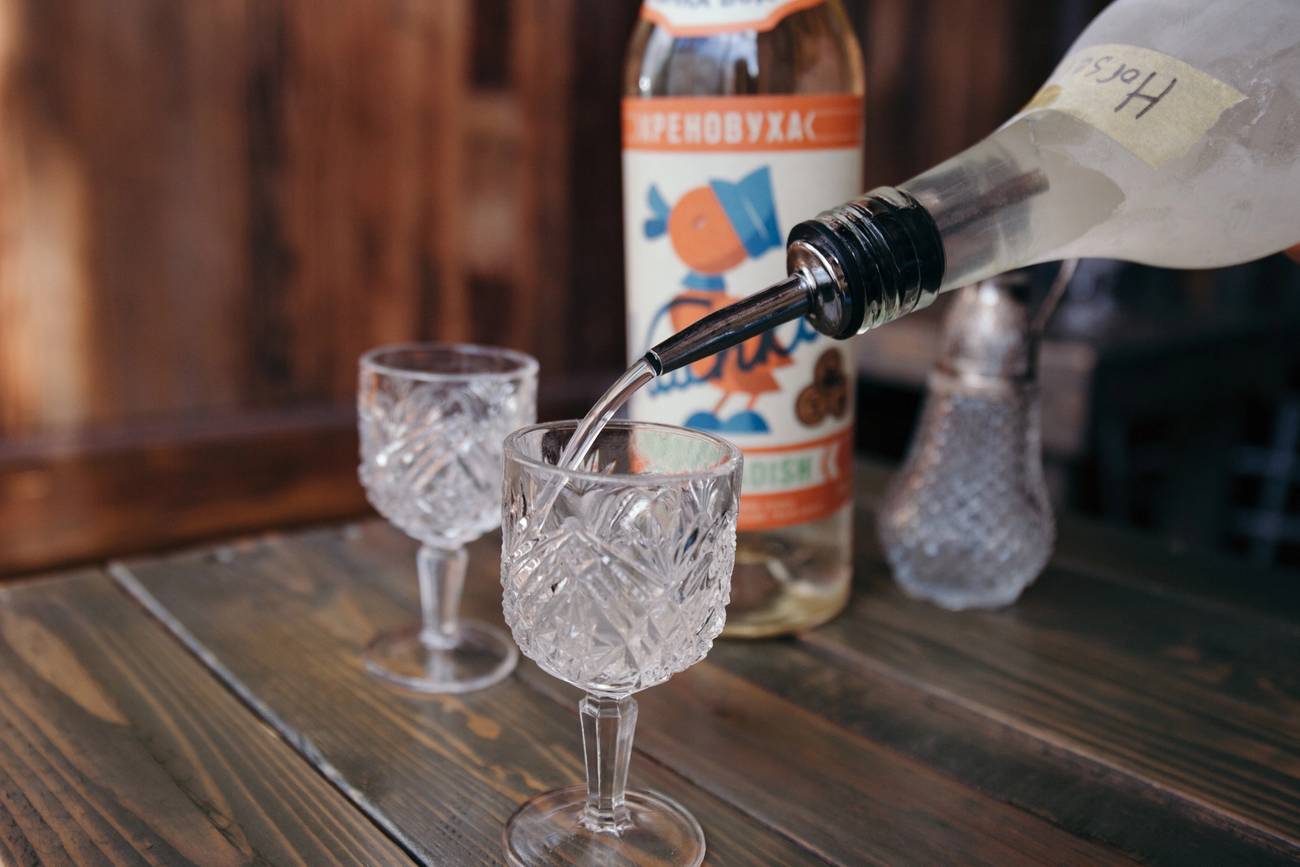The Perfect Seder Shot
Horseradish-infused vodka brings ‘maror’ to a new level



For me, and just about any child attending a Passover Seder, the greatest moment of delight arrives with the maror—when everyone around the table blesses and then bravely consumes a bite of horseradish. Eyes collectively widen, throats are set ablaze, and sputtering exclamations ensue. Sure, eating horseradish is meant to embody the hardships the Israelites experienced in ancient Egypt, but the experience itself is nothing short of exhilarating.
In Portland, Oregon, that maror moment is recreated on a daily basis at Kachka, the contemporary Russian restaurant founded by chef Bonnie Frumkin Morales and her husband, Israel Morales. There, diners can pair their zakuski (smoked fish, pickles, fish roe, buckwheat blini, and other appetizers) with a variety of vodkas infused in-house with ingredients like cacao nib, Siberian pine nut shell, birch, Earl Grey, and, most notably, horseradish. Together they toast and down shots, experiencing the vodka’s fiery drama without all the bitter symbolism.
Vodka is, of course, essentially synonymous with Russian cuisine. As professor and historian Darra Goldstein writes in her new cookbook, Beyond the North Wind: Russia in Recipes and Lore, “vodka and caviar are indeed iconically Russian—and ideal complements to each other.” Distilled, grain-based spirits, she writes, were likely introduced to Russia in the 15th century and entered the domestic mainstream in the late 16th century. The Russian word “vodka,” which evolved a couple of centuries after the drink itself, is a “diminutive, affectionate form of ‘water,’”—a cultural lifeblood, in other words. Meanwhile, horseradish-root-infused alcohol is so common within Russian cuisine, the category has its own name: hrenovuha (“thing made with horseradish”).
Frumkin Morales’ family, Jewish immigrants from Belarus who relocated to Chicago, did not make horseradish vodka when she was growing up. But they did imbibe other homemade spirits, particularly fruit-based liquors where sugar-macerated berries were allowed to sit on the windowsill until they fermented into a heady brandy. Frumkin Morales and her husband, who runs Kachka’s bar program, got the inspiration to serve horseradish-infused vodka to their customers during a culinary research trip to St. Petersburg in 2013. “We thought it would be esoteric, but it was an instant overnight success,” she said. “Now it is one of the things people talk about when they talk about our menu.”
Kachka’s version is made with Oregon-grown horseradish and includes a touch of local honey—not enough to imbue the drink with sweetness, Frumkin Morales said, but enough to round out the rough edges. “You get the kick without the bite,” she said. The vodka they usually use is grain-based. But during the week of Passover, they switch the spirit to a grape-based vodka in a nod to the Seder’s customary four glasses of wine. (Potato vodkas are more commonly associated with Poland than Russia—but they are kosher for Passover.)
At Kachka, the spirit is served ice cold and intended to be downed in a straight shot. “People think you freeze vodkas to mask cheap quality,” Frumkin Morales said. “But cold temperatures change its viscosity for the better—it is the traditional way of serving it.” Goldstein concurs: As she writes in Beyond the North Wind, “I always keep bottles in the freezer, ready for immediate consumption ... the sensation of the icy liquid coursing through your body is quite wonderful—warming in the winter, refreshing in the summer.”
For a few years, Kachka sold bottles of their horseradish vodka at Oregon liquor stores, as well as serving it in their restaurants. This past fall, they opened Kachka Lavka, a petite but well-stocked Russian deli and grocery located upstairs from Kachka’s dining room, as a venue to retail it themselves. They took a temporary pause to tweak productions to match federal regulations, but plan to relaunch the product soon—first all over Oregon, and eventually in other states as well.
In the meantime, a DIY recipe for their horseradish vodka can be found in Kachka: A Return to Russian Cooking, the award-winning cookbook Frumkin Morales co-wrote with journalist Deena Prichep in 2017. The recipe calls for the horseradish to steep for one week in the vodka, imparting a rich and bracing burn to the alcohol. “It wakes you up,” Frumkin Morales said. “It is really energizing.”
Goldstein’s book also includes a recipe for horseradish vodka (along with vodkas infused with peppercorns, sweet cherries, tarragon, and birch buds). In her take, the horseradish only sits in the vodka for 24-48 hours, resulting in a mellower but still powerful spirit worth toasting to. And when made with a Passover-friendly vodka, either version would make a welcome—and decadent—addition to a Passover Seder. As Goldstein puts it, “‘Moderation in all things’” is a Greek motto, not a Russian one.”